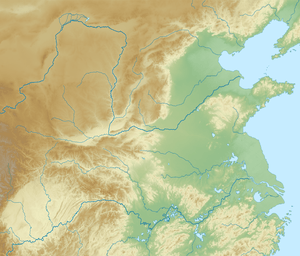Shimao
| 石峁 | |
 Location in north China | |
| Location | China |
|---|---|
| Region | Shaanxi |
| Coordinates | 38°33′57″N 110°19′31″E / 38.5657°N 110.3252°ECoordinates: 38°33′57″N 110°19′31″E / 38.5657°N 110.3252°E |
| Area | 400 ha |
| History | |
| Founded | c. 2000 BC |
Shimao (Chinese: 石峁; pinyin: Shímǎo) is a Neolithic site in Shenmu County, Shaanxi, China. The site is located in the northern part of the Loess Plateau, on the southern edge of the Ordos Desert. It is dated to around 2000 BC, near the end of the Longshan period, and is the largest known walled site of that period in China, at 400 ha.[1][2]
The city was surrounded by inner and outer stone walls, in contrast to the rammed earth walls typical of Longshan sites in the Central Plain and Shandong. The walls were 2.5 meters thick on average, with perimeters of approximately 4200 m and 5700 m respectively, and feature gates, turrets and watch towers. The inner city contained a stone-walled platform, interpreted as a palatial complex, and densely packed residential zones, cemeteries and craft workshops. Unusual features include jade embedded in the city walls, possibly to provide spiritual protection, and paintings of geometrical patterns on the inner walls. Many human skulls were found under the city gate, suggesting ritual sacrifices during construction.[1][3][4]
Gallery
 Jade head, Shaanxi History Museum
Jade head, Shaanxi History Museum
References
- 1 2 Sun, Zhouyong (2013). "Shimao: A Stone-Walled Settlement of the 2nd Millennium BC in Northern China". Institute of Archaeology, Chinese Academy of Social Sciences.
- ↑ Jaang, Li; Sun, Zhouyong; Shao, Jing; Li, Min (2018). "When peripheries were centres: a preliminary study of the Shimao-centred polity in the loess highland, China". Antiquity. 92 (364): 1008–1022. doi:10.15184/aqy.2018.31. ISSN 0003-598X.
- ↑ "Neolithic city ruins shed light on the dawn of Chinese civilization". China Central Television. 27 August 2013. Retrieved 9 April 2016.
- ↑ "Shaanxi skull find shows women were sacrificed in ancient China". South China Morning Post. 2 December 2013. Retrieved 9 April 2016.